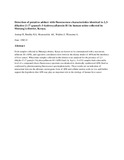| dc.contributor.author | Autrup, H | |
| dc.contributor.author | Bradley, KA | |
| dc.contributor.author | Shamsuddin, AK | |
| dc.contributor.author | Wakhisi, J | |
| dc.contributor.author | Wasunna, A | |
| dc.date.accessioned | 2013-10-15T08:05:36Z | |
| dc.date.available | 2013-10-15T08:05:36Z | |
| dc.date.issued | 1983 | |
| dc.identifier.citation | Carcinogenesis. 1983 Sep;4(9):1193-5. | en |
| dc.identifier.uri | http://www.ncbi.nlm.nih.gov/pubmed/6411378 | |
| dc.identifier.uri | http://erepository.uonbi.ac.ke:8080/xmlui/handle/123456789/57623 | |
| dc.description.abstract | Food samples collected in Murang'a district, Kenya are known to be contaminated with a mycotoxin, aflatoxin B1 (AFB), and a positive correlation exists between the dietary intake of AFB and the incidence of liver cancer. When urine samples collected in this district were analyzed for the presence of 2,3-dihydro-2-(7'-guanyl)-3-hydroxyaflatoxin B1 (AFB-GuaI) by h.p.l.c., 6 of 81 samples had a detectable level of a compound whose fluorescence spectrum was identical to chemically synthesized AFB-GuaI as confirmed by photoncounting fluorescence spectrophotometry. These results are an indication of interaction between the ultimate carcinogenic form of AFB and cellular nucleic acids in vivo and further support the hypothesis that AFB may play an important role in the etiology of human liver cancer. | en |
| dc.language.iso | en | en |
| dc.publisher | Oxford Journals | en |
| dc.title | Detection of putative adduct with fluorescence characteristics identical to 2,3-dihydro-2-(7'-guanyl)-3-hydroxyaflatoxin B1 in human urine collected in Murang'a district, Kenya. | en |
| dc.type | Article | en |
| local.publisher | College of Health Sciences, University of Nairobi | en |

